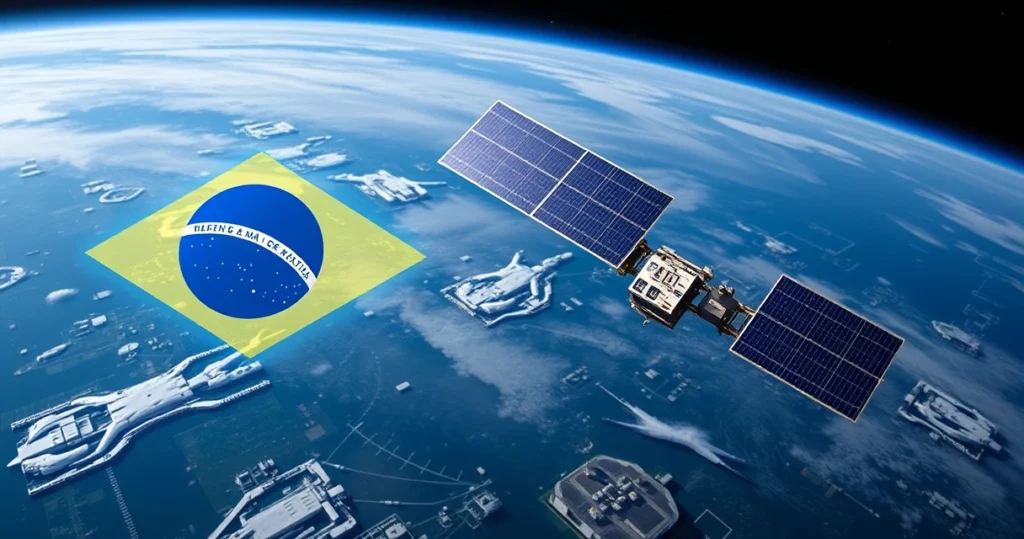In a significant advancement for both nations, Brazil and China have formalized an agreement to launch the CBERS-5, Brazil’s first geo-stationary satellite aimed at collecting vital environmental and meteorological data. This partnership not only highlights the growing collaboration between the two countries but also marks a pivotal moment in Brazil’s space capabilities. The CBERS (China-Brazil Earth Resources Satellite) program, which began in 1988, has evolved to include this cutting-edge satellite, promising to deliver enhanced observational data that can contribute to environmental management and disaster response.

The need for sophisticated monitoring systems has never been more pressing. With climate change and environmental degradation impacting ecosystems globally, Brazil and China’s collaboration on the CBERS-5 allows both countries to leverage their technological expertise and resources to address these challenges. In this article, we will delve into the details of this groundbreaking project, its significance, and potential implications for environmental data collection.
The Significance of the CBERS-5 Satellite
The CBERS-5 satellite represents a monumental leap for Brazil in the realm of space technology. By entering the geo-stationary orbit, the satellite will be positioned to provide continuous monitoring of weather patterns, environmental changes, and other critical data over the Brazilian territory and parts of the surrounding regions. This capability holds vast potential for both immediate and long-term applications.
Enhanced Monitoring of Environmental Changes
As climate change poses significant risks to natural resources and human livelihoods, the CBERS-5 will play a crucial role in monitoring these changes. By analyzing data from the satellite, scientists and policymakers can better understand phenomena such as deforestation, land use change, and natural disasters. This data can be pivotal in formulating effective policies to combat environmental degradation.
Support for Disaster Management Efforts
Natural disasters, including floods, droughts, and wildfires, pose a constant threat to Brazil’s biodiversity and its populations. With its geo-stationary capabilities, the CBERS-5 can provide real-time data that can be used to predict and manage these disasters. This timely information can aid emergency services and government agencies in implementing effective response strategies, ultimately saving lives and resources.
Technological Innovations and Collaboration
Brazil and China’s partnership in developing the CBERS-5 satellite showcases a blend of technological prowess and collaborative spirit. The two nations bring unique strengths to the table: Brazil’s extensive knowledge of the Amazon rainforest and China’s advanced satellite technology.
Technical Features of the CBERS-5
The CBERS-5 is designed to feature state-of-the-art sensors capable of capturing high-resolution images and data. These technical advancements will enable the satellite to operate efficiently in various weather conditions, ensuring the reliability of the data collected. The satellite is expected to include:
- High-resolution imaging capabilities for detailed environmental assessments.
- Multi-spectral sensors to capture diverse data on land and vegetation.
- Real-time data transmission for immediate analysis and application.
- Advanced algorithms for data processing to enhance accuracy.
International Collaboration and Knowledge Sharing
This project also emphasizes the importance of international collaboration in space exploration and environmental monitoring. By pooling resources and expertise, Brazil and China can accelerate technological development while fostering goodwill and mutual understanding. The exchange of knowledge and experience will benefit both nations, enhancing their capabilities in space science and environmental management.
Implications for Brazil’s Environmental Policy
With the launch of the CBERS-5, Brazil is poised to enhance its environmental policies significantly. The satellite will provide crucial data that can be utilized to monitor compliance with environmental regulations, assess the effectiveness of conservation efforts, and implement measures to protect biodiversity.
Strengthening Environmental Legislation
The data obtained from the CBERS-5 will empower policymakers with evidence-based insights, enabling them to create robust environmental legislation. By continuously monitoring land use and environmental health, Brazil can ensure that its policies are aligned with the sustainable management of natural resources.
Engaging Local Communities
Furthermore, the availability of accurate environmental data can foster greater community engagement in conservation efforts. Local communities can be informed of the changes occurring in their environments and be encouraged to participate in initiatives aimed at preserving their natural surroundings. This grassroots involvement is often essential for the long-term success of environmental policies.
Conclusion: A Bright Future Ahead
The launch of the CBERS-5 satellite represents a promising step forward for Brazil and China, one that is poised to bolster environmental monitoring and management capabilities significantly. This collaboration between the two countries is not just about technology; it is about addressing urgent global challenges through shared knowledge and resources. As the world continues to grapple with the effects of climate change, initiatives like the CBERS-5 are crucial in managing our planet’s health and ensuring a sustainable future for generations to come.
FAQs
1. What is the purpose of the CBERS-5 satellite?
The CBERS-5 satellite aims to collect environmental and meteorological data to monitor changes in land use, weather patterns, and natural disasters in Brazil and surrounding regions.
2. How will the CBERS-5 benefit Brazil’s environmental policies?
The satellite will provide critical data that can help policymakers create evidence-based environmental regulations and assess the effectiveness of conservation efforts.
3. What technological features does the CBERS-5 have?
The CBERS-5 is equipped with high-resolution imaging capabilities, multi-spectral sensors, real-time data transmission, and advanced data processing algorithms.
4. How does international collaboration enhance the CBERS-5 project?
International collaboration allows for the pooling of resources and expertise, accelerating technological development and fostering goodwill between Brazil and China.
5. What role will local communities play in the environmental monitoring facilitated by CBERS-5?
Local communities can engage in conservation efforts by utilizing the data provided by the CBERS-5 to understand environmental changes and take action to preserve their surroundings.
📰 Original Source
Este artigo foi baseado em informações de: https://olhardigital.com.br/2025/07/06/ciencia-e-espaco/brasil-e-china-firmam-acordo-para-lancar-satelite-geoestacionario/



